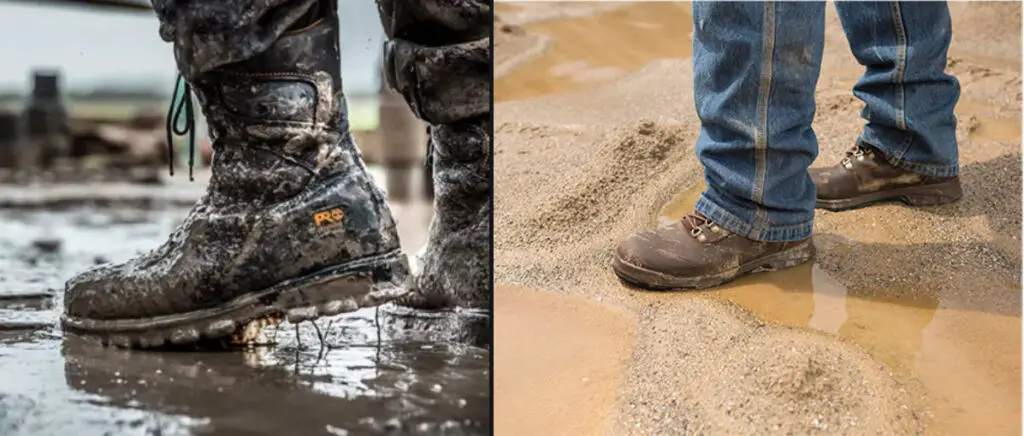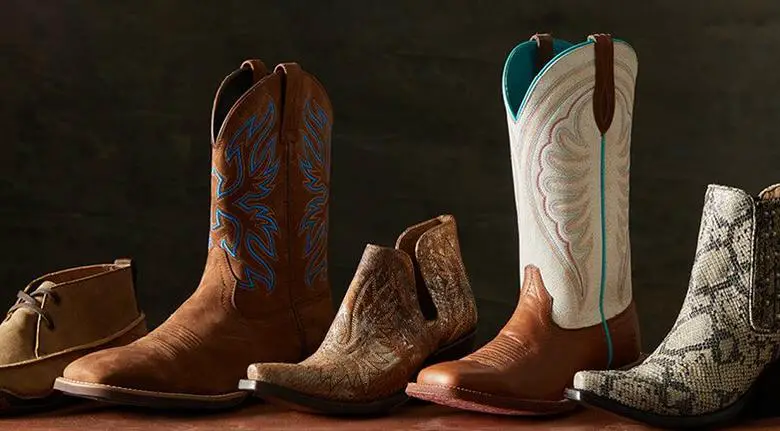Oil and slip-resistant are both important features in your work boot that provide traction and protection from falling and injuring yourself.
Without these features, you cannot claim full guarantee of your safety because a good pair of work boots comes with these important features.
Oil resistant is not the same as slip resistant but there are very subtle differences between them. Usually oil-resistant boots are made of an upper material that repels oil and does not let it seep in through the surface. Whereas slip-resistant boots have a special sole made of rubber, containing tread patterns that won’t let you trip and fall.

In this article, we’ll discuss all the important points that you need to know about oil and slip-resistant boots.
The terms oil resistance and slip resistance are two different things. But, if we examine them from the standpoint of footwear, we can see they have slight differences:
| Oil resistant | Slip resistant |
| It covers the complete structure of the boot since you need to protect your footwear from the negative effects of oil, which you can’t achieve if all of the sections aren’t oil repellent.
Boots with oil resistant features are less likely to be severely ruined. Oil-resistant boots are long-lasting because they survive longer when exposed to non-hazardous oil. Oil resistant feature covers the entire surface of the footwear. |
It merely involves altering the soles of the boots in order to protect you from falling.
Because you can injure any area of your body if you slip and fall, slip resistance seeks to prevent damage to your whole body. Slip-resistant boots are designed to keep you safe on slick or wet surfaces, but too much water exposure might shorten their longevity. Slip resistant feature is for your overall well-being. |
How do you know if your work boot is oil-resistant?
First and foremost, if you want to know if your boots are oil-resistant, glance at the bottom to see if there is any layer of coating. If you see a label that says “oil resistant,” you may be guaranteed that it will keep you safe in an oily, greasy environment.
Check the tread because oil-resistant boots will have a distinct tread pattern. Take a look at the sole’s structure. Look for the source as well as the grooves. Also, get a sense of the bottom.
How do you identify a boot that is slip-resistant?
The outsole tread pattern and sole composition are two factors that make a work boot slip-resistant.
Work boots with round or hexagonal treads are also a strong indicator of how slip-resistant they are. Deep ridges between the treads of slip-resistant boots help keep the wearer standing throughout the day.
If you’re wondering if you need to purchase two different types of work boots that need to be worn in different environments, then here in this article, we have good news for you.
Can a work boot have both oil and slip-resistant features?
YES! Oil and slip-resistant features can be both present in a single pair of your work boots. Even if a boot is built of oil-resistant materials, the sole can be modified to be slip-resistant.
Because walking on oil can cause you to slip if you’re wearing regular boots, therefore most oil-resistant shoes are also slip-resistant.
DIY tips to make the sole less slippery and oil resistant
1.) Roughen up your boots’ soles. This is a proven technique to give your soles some traction. Scrape the soles of your shoes against any rough surface, such as cement or gravel, to roughen them up and give them that non-slippery feature at home.
2.) Traction spray might help you get the grip you need on your soles. They coat the sole and provide the necessary traction. However, if you want the traction to last, you’ll have to do it on a regular basis.
Check out this spray by Bare Ground which is a Spray on Adhesive Spray for Slippery Surfaces-
- Added traction on slippery surfaces to reduce slips and falls
- Spray Shoe Grip on the soles of your shoes, let dry, and go
- Will not harm leather or rubber
- Specially designed nozzle to spray the targeted area without waste
- Safe to use indoors and out - great for tile, wooden floors, boating, and docks
Prices pulled from the Amazon Product Advertising API on:
Product prices and availability are accurate as of the date/time indicated and are subject to change. Any price and availability information displayed on [relevant Amazon Site(s), as applicable] at the time of purchase will apply to the purchase of this product.
3.) Another method for making your work boots slip-resistant is to apply a 1:2 mixture of salt and rubber glue to the outsole of the shoe and let it dry for an hour. They will be significantly more anti-slip.
4.) Hairspray can also be used to spray your soles. This will give you a similar result to using traction spray purchased from a store, but at a reduced cost. This is a speedy remedy, but you’ll have to reapply every day to maintain the non-slip quality.
5.) You can use a knife to scrape your soles. Although this is a simple technique, it works wonders because a shoe with a good tread pattern provides a lot of traction, which results in good grip and your overall safety.
Some FAQs to help you out-
1.) Oil-resistant work boots are ideal for whom?
If you operate in an environment with oils, grease, lubricants, chemicals, corrosives, or other similar hazardous compounds on a regular basis, then oil-resistant boots are an absolute must for your safety.
2.) Who should use slip-resistant boots?
In many industries where there is a risk of slipping, slip-resistant footwear is now mandatory. People working in the food and catering business, healthcare, manufacturing, and warehouses should all be using work boots that have slip-resistant features.
They’re also useful for preventing slip and fall on high surfaces like ladders and work platforms. As a result, slip-resistant footwear can help you avoid major injury.
Recommended oil-resistant work boots
1.) Dr. Martens Steel Toe Work Boots
- Rich, water resistant tumbled leather uppers on a welted construction foot bed
- Constructed with DMs durable air-cushioned PVC sole and fitted with an EVA foot bed and padded ankle support
- Offers protection against electrical hazards - Standard: ASTM F2413-11 MI/75 C/75 EH
- The iconic Dr. Martens air-cushioned sole is resistant to oil, fat, petrol and alkali
Prices pulled from the Amazon Product Advertising API on:
Product prices and availability are accurate as of the date/time indicated and are subject to change. Any price and availability information displayed on [relevant Amazon Site(s), as applicable] at the time of purchase will apply to the purchase of this product.
These oil-resistant heavy-industrial boots are an excellent choice. Plus they have soles made of PVC that are known for resisting oil, grease and chemicals.
2.) Danner Alloy Toe Work Boots
- 100% Leather
- Vibram sole
- Made in US
Prices pulled from the Amazon Product Advertising API on:
Product prices and availability are accurate as of the date/time indicated and are subject to change. Any price and availability information displayed on [relevant Amazon Site(s), as applicable] at the time of purchase will apply to the purchase of this product.
The vibram sole feature does not allow oil and moisture to seep inside your boot keeping it safe and clean. It also provides excellent grip on oily and uneven surfaces.
3.) Thorogood Oil Rigger Safety Toe Boot
- Heavily oiled, full-grain black walnut leather 804-3231
- Removable, Ultimate Shock Absorption footbed on Poron comfort cushion footbed
- Triple ladder steel shank
- Vibram SO498 outsole with TC4 compound
- Goodyear storm welt construct
Prices pulled from the Amazon Product Advertising API on:
Product prices and availability are accurate as of the date/time indicated and are subject to change. Any price and availability information displayed on [relevant Amazon Site(s), as applicable] at the time of purchase will apply to the purchase of this product.
This boot comes with a vibram sole that provides good traction and is highly resistant to oils and chemicals.
Recommended slip-resistant work boots
1.) Ever Boots Soft Toe
- Goodyear Welt Construction is the toughest shoe construction ever invented.
- Soft leather take the pain out of breaking into a new pair of work boots.
- PU Insole provides maximum comfort to your feet and long stand hours.
- True size to big brand work boots.
Prices pulled from the Amazon Product Advertising API on:
Product prices and availability are accurate as of the date/time indicated and are subject to change. Any price and availability information displayed on [relevant Amazon Site(s), as applicable] at the time of purchase will apply to the purchase of this product.
These boots come with a rubber sole that provides stability against wet, slippery surfaces. It is also very comfortable and ideal for people who are on their feet for a long time.
2.) NORTIV Anti-Slip Tactical Boots
- Work boot with a steel safety toe protects the toes in most cases
- YKK side zipper and lace-up two closure design make your every steps safety
- Cushioned EVA footbed for reliable comfort and shock absorption
- Puncture resistant midsole and the durable rubber outsole is abrasion and slip-resistant
- Construction boots feature a roomier toe box that protects your feet and suitable for heavy-duty work
Prices pulled from the Amazon Product Advertising API on:
Product prices and availability are accurate as of the date/time indicated and are subject to change. Any price and availability information displayed on [relevant Amazon Site(s), as applicable] at the time of purchase will apply to the purchase of this product.
With an anti-slip feature, these boots are an ideal pair of safety work boots that are also comfortable because of the cushioning on the footbed that keeps the arch pain away.
3.) Dunlop Protective Footwear
- PUROFORT@ upper for all day comfort
- SRC rated, dirt-repellent Vibram outsole for perfect grip
- ASTM/ CSA certified Steel Toe Steel Midplate
- Insulates down to -4F
- up to 40% more flexible than rub
Prices pulled from the Amazon Product Advertising API on:
Product prices and availability are accurate as of the date/time indicated and are subject to change. Any price and availability information displayed on [relevant Amazon Site(s), as applicable] at the time of purchase will apply to the purchase of this product.
The vibram rubber outsoles on these boots have been carefully created to prevent you from falling and injuring yourself.
Conclusion
When working in environments where your feet are at risk, you’ll need both oil and slip resistant features in your shoes to ensure you don’t lose your stability while walking or standing on oil, water, or grease. If you’ve been a little perplexed by the subject, we hope this article has cleared things up for you.














